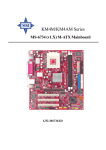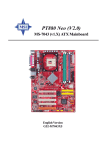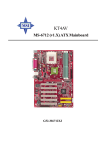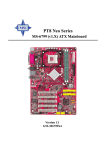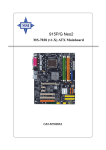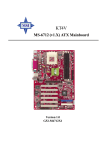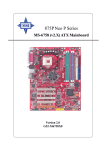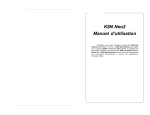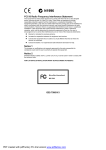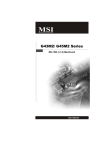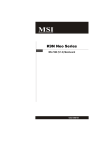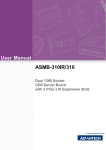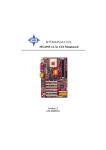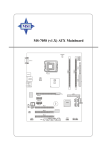Download MSI 848P Neo-V Motherboard
Transcript
865PE Neo2-V / 848P Neo-V Series MS-6788 (v2.X) ATX Mainboard G52-M6788X7 i Manual Rev: 2.0 Release Date: February 2004 FCC-B Radio Frequency Interference Statement This equipment has been tested and found to comply with the limits for a class B digital device, pursuant to part 15 of the FCC rules. These limits are designed to provide reasonable protection against harmful interference when the equipment is operated in a commercial environment. This equipment generates, uses and can radiate radio frequency energy and, if not installed and used in accordance with the instruction manual, may cause harmful interference to radio communications. Operation of this equipment in a residential area is likely to cause harmful interference, in which case the user will be required to correct the interference at his own expense. Notice 1 The changes or modifications not expressly approved by the party responsible for compliance could void the user’s authority to operate the equipment. Notice 2 Shielded interface cables and A.C. power cord, if any, must be used in order to comply with the emission limits. VOIR LA NOTICE D’INSTALLATION AVANT DE RACCORDER AU RESEAU. Micro-Star International MS-6788 ii Copyright Notice The material in this document is the intellectual property of MICRO-STAR INTERNATIONAL. We take every care in the preparation of this document, but no guarantee is given as to the correctness of its contents. Our products are under continual improvement and we reserve the right to make changes without notice. Trademarks All trademarks are the properties of their respective owners. AMD, Athlon™, Athlon™ XP, Thoroughbred™, and Duron™ are registered trademarks of AMD Corporation. Intel ® and Pentium® are registered trademarks of Intel Corporation. PS/2 and OS ® /2 are registered trademarks of International Business Machines Corporation. Microsoft is a registered trademark of Microsoft Corporation. Windows® 98/2000/NT/ XP are registered trademarks of Microsoft Corporation. NVIDIA, the NVIDIA logo, DualNet, and nForce are registered trademarks or trademarks of NVIDIA Corporation in the United States and/or other countries. Netware ® is a registered trademark of Novell, Inc. Award® is a registered trademark of Phoenix Technologies Ltd. AMI® is a registered trademark of American Megatrends Inc. Kensington and MicroSaver are registered trademarks of the Kensington Technology Group. PCMCIA and CardBus are registered trademarks of the Personal Computer Memory Card International Association. Revision History Revision V1.0 V1.1 V2.0 Revision History First release for PCB 1.X with Intel® 848P & Intel® ICH5 Audio driver updates First release for PCB 2.X with Intel® 865PE/848P & Intel® ICH5 iii Date August 2003 October 2003 February 2004 Technical Support If a problem arises with your system and no solution can be obtained from the user’s manual, please contact your place of purchase or local distributor. Alternatively, please try the following help resources for further guidance. h Visit the MSI homepage & FAQ site for technical guide, BIOS updates, driver updates, and other information: http://www.msi.com.tw & http://www.msi. com.tw/program/service/faq/faq/esc_faq_list.php h Contact our technical staff at: [email protected] Safety Instructions 1. 2. 3. 4. 5. Always read the safety instructions carefully. Keep this User’s Manual for future reference. Keep this equipment away from humidity. Lay this equipment on a reliable flat surface before setting it up. The openings on the enclosure are for air convection hence protects the equipment from overheating. Do not cover the openings. 6. Make sure the voltage of the power source and adjust properly 110/220V before connecting the equipment to the power inlet. 7. Place the power cord such a way that people can not step on it. Do not place anything over the power cord. 8. Always Unplug the Power Cord before inserting any add-on card or module. 9. All cautions and warnings on the equipment should be noted. 10. Never pour any liquid into the opening that could damage or cause electrical shock. 11. If any of the following situations arises, get the equipment checked by a service personnel: h The power cord or plug is damaged. h Liquid has penetrated into the equipment. h The equipment has been exposed to moisture. h The equipment has not work well or you can not get it work according to User’s Manual. h The equipment has dropped and damaged. h The equipment has obvious sign of breakage. 12. Do not leave this equipment in an environment unconditioned, storage temperature above 60 0 C (140 0F), it may damage the equipment. CAUTION: Danger of explosion if battery is incorrectly replaced. Replace only with the same or equivalent type recommended by the manufacturer. iv CONTENTS FCC-B Radio Frequency Interference Statement ........................................................ ii Copyright Notice ........................................................................................................... iii Revision History ............................................................................................................ iii Safety Instructions ...................................................................................................... iv Technical Support ........................................................................................................ iv Chapter 1. Getting Started ................................................................................... 1-1 Mainboard Specifications .................................................................................. 1-2 Mainboard Layout .............................................................................................. 1-4 Chapter 2. Hardware Setup ................................................................................. 2-1 Quick Components Guide .................................................................................. 2-2 Central Processing Unit: CPU ............................................................................ 2-3 Example of CPU Core Speed Derivation Procedure ................................. 2-3 Memory Speed/CPU FSB Support Matrix .................................................. 2-3 CPU Installation Procedures for Socket 478 ............................................. 2-5 Installing the CPU Fan ................................................................................. 2-5 Memory ............................................................................................................... 2-7 Introduction to DDR SDRAM ....................................................................... 2-7 DDR Population Rules ................................................................................. 2-7 Dual-channel DDR Introduction .................................................................. 2-8 Installing DDR Modules ............................................................................... 2-8 Power Supply ..................................................................................................... 2-9 ATX 20-Pin Power Connector: ATX1 ......................................................... 2-9 ATX 12V Power Connector: JPW1 ............................................................ 2-9 Back Panel ........................................................................................................ 2-10 Mouse Connector ..................................................................................... 2-10 Keyboard Connector ................................................................................ 2-10 Serial Port Connector: COM A .................................................................. 2-11 USB Connectors ....................................................................................... 2-11 SPDIF-out Port Connector ........................................................................ 2-11 RJ-45 LAN Jack: 10/100 LAN (8100C) /Giga-bit LAN (8110S) (Optional) ..................................................................... 2-12 Audio Port Connectors ............................................................................. 2-12 Parallel Port Connector: LPT1 .................................................................. 2-13 Connectors ....................................................................................................... 2-14 Floppy Disk Drive Connector: FDD1 ........................................................ 2-14 Fan Power Connectors: CPUFAN1/SYSFAN1 ........................................ 2-14 v CD-In Connector: CD1 .............................................................................. 2-14 ATA100 Hard Disk Connectors: IDE1 & IDE2 ........................................... 2-15 Front USB Connectors: JUSB2 & JUSB3 ................................................ 2-15 Serial ATA HDD Connectors: SATA1, SATA2 .......................................... 2-16 S-Bracket (SPDIF) Connector: JSP1 (Optional) ...................................... 2-17 Front Panel Connectors: JFP1 & JFP2 ..................................................... 2-18 Front Panel Audio Connector: JAUD1 ..................................................... 2-19 D-Bracket™ 2 Connector: JDB1 (Optional) ............................................ 2-20 Jumpers ............................................................................................................ 2-21 Clear CMOS Jumper: JBAT1 .................................................................... 2-21 Slots .................................................................................................................. 2-22 AGP (Accelerated Graphics Port) Slot ................................................... 2-22 PCI (Peripheral Component Interconnect) Slots ...................................... 2-22 PCI Interrupt Request Routing .................................................................. 2-22 Chapter 3. BIOS Setup ........................................................................................... 3-1 Entering Setup .................................................................................................... 3-2 Selecting the First Boot Device ................................................................. 3-2 Control Keys ............................................................................................... 3-3 Getting Help ................................................................................................ 3-3 Main Menu ................................................................................................... 3-3 Default Settings .......................................................................................... 3-3 The Main Menu ................................................................................................... 3-4 Standard CMOS Features .................................................................................. 3-6 Advanced BIOS Features .................................................................................. 3-8 Advanced Chipset Features ........................................................................... 3-11 Power Management Features ......................................................................... 3-13 PNP/PCI Configurations .................................................................................... 3-16 Integrated Peripherals ...................................................................................... 3-19 PC Health Status .............................................................................................. 3-23 Frequency/Voltage Control .............................................................................. 3-24 Set Supervisor/User Password ...................................................................... 3-27 Load High Performance/BIOS Setup Defaults ................................................ 3-28 vi Getting Started Chapter 1. Getting Started Getting Started Thank you for choosing the 865PE Neo2-V / 848P Neo-V Series (MS-6788) v2.X ATX mainboard. The 865PE Neo2-V / 848P Neo-V Series is based on Intel® 865PE / 848P and ICH5 chipsets for optimal system efficiency. Designed to fit the advanced Intel® Pentium® 4 processors in 478 pin package, the 865PE Neo2-V / 848P Neo-V Series delivers a high performance and professional desktop platform solution. 1-1 MS-6788 ATX Mainboard Mainboard Specifications CPU h Supports Intel® P4 Northwood / Prescott (Socket 478) processors. h FSB 400MHz (for Northwood only) / 533MHz / 800MHz depending on the North Bridge integrated. h Supports up to 3.4GHz or higher speed P4 processor. (For the latest information about CPU, please visit http://www.msi.com.tw/program/ products/mainboard/mbd/pro_mbd_cpu_support.php) Chipset h Intel® 865PE / 848P chipset - Supports 400/533/800MHz Intel NetBurst micro-architecture bus. - Supports AGP 8X/4X interface. - Supports DDR266/333/400 memory interface. h Intel® ICH5 chipset - 8 Hi-Speed USB ports (USB2.0/1.1) controller, 480Mb/sec. - 2 Serial ATA/150 ports. - 2 channel Ultra ATA 100 bus Master IDE controller. - PCI Master v2.3. - I/O APIC. Main Memory h Supports bandwidth up to 3.2 GB/s (DDR 400) for single-channel mode and 6. 4GB/s (DDR 400) for dual-channel mode (for 865PE only). h Supports two (for 848P) / three (for 865PE) unbuffered DIMM of 2.5 Volt DDR SDRAM h Supports up to 2GB (for 848P) / 3GB (for 865PE) memory size without ECC. h Supports only x8, x16 DDR devices. h Supports Dual-channel (for 865PE only) DDR 266/333/400 (based on DIMM 1.3). (For the updated supporting memory modules, please visit http://www.msi.com.tw/ program/products/mainboard/mbd/pro_mbd_trp_list.php.) Slots h One AGP slot supports 8x/4x. h Five 32-bit v2.3 Master PCI bus slots (supports 3.3v/5v PCI bus interface). On-Board IDE h Dual Ultra DMA 66/100 IDE controllers integrated in ICH5. - Supports PIO, Bus Master operation modes. - Can connect up to four Ultra ATA drives. h Serial ATA/150 controller integrated in ICH5. - Up to 150MB/sec transfer rate. - Can connect up to 2 Serial ATA drives. 1-2 Getting Started On-Board Peripherals h On-Board Peripherals includes: - 1 floppy port supports 1 FDDs with 360K, 720K, 1.2M, 1.44M and 2.88Mbytes - 1 serial port COM1 - 1 parallel port supports SPP/EPP/ECP mode - 8 USB 2.0 ports (Rear * 4/ Front * 4) - 1 Line-In/Line-Out/Mic-In port - 1 RJ45 LAN jack (Optional) - 1 RCA SPDIF Out Audio h AC’97 link controller integrated in ICH5. h 6 channels software audio codec ALC655. - Compliance with AC97 v2.2 Spec. - Meet PC2001 audio performance requirement. LAN (Optional) h Realtek® 8110S/8100C Dual layout. - Integrated Fast Ethernet MAC and PHY in one chip. - Supports 10Mb/s, 100Mb/s and 1000Mb/s (1000Mb/s is only for Realtek 8110S) auto-negotiation operation. - Compliant with PCI v2.2. - Supports ACPI Power Management. BIOS h The mainboard BIOS provides “Plug & Play” BIOS which detects the peripheral devices and expansion cards of the board automatically. h The mainboard provides a Desktop Management Interface (DMI) function which records your mainboard specifications. Dimension h ATX Form Factor: 29.5 cm (L) x 21.0 cm (W). Mounting h 6 mounting holes. 1-3 MS-6788 ATX Mainboard Mainboard Layout CP UFAN1 Top : mouse Bottom : keyboard ATX Power Supply T:SP DIF Out B:USB ports T:LAN jack (Optional) B:USB ports Intel 865PE JPW1 AGP Slot BIOS Winb ond W83627THF DIMM 3 DIMM 1 chipset DIMM 2 T:Line-In M: Line-Out B:Mic PCI Slot 1 SATA2 ICH 5 PCI Slot 2 Realtek 8110S/8100C SATA1 PCI Slot 3 IDE 2 CD1 PCI Slot 4 IDE 1 SYSFAN1 Codec PCI Slot 5 US B2 JAUD 1 JSP1 FDD1 BATT + JDB1 JBAT1 JFP1 US B3 JFP2 865PE Neo2-V (MS-6788 v2.X) ATX Mainboard 1-4 Getting Started CP UFAN1 Top : mouse Bottom : keyboard ATX Power Supply T:SP DIF Out B:USB ports T:LAN jack (Optional) B:USB ports Intel 848P JPW1 DIMM 1 chipset AGP Slot BIOS Winb ond W83627THF DIMM 2 T:Line-In M: Line-Out B:Mic PCI Slot 1 SATA2 ICH 5 PCI Slot 2 Realtek 8110S/8100C SATA1 PCI Slot 3 IDE 2 CD1 PCI Slot 4 IDE 1 SYSFAN 1 Codec PCI Slot 5 US B2 JAUD1 JSP1 FDD1 BATT + JDB1 JBAT1 JFP1 US B3 JFP2 848P Neo-V (MS-6788 v2.X) ATX Mainboard 1-5 Hardware Setup Chapter 2. Hardware Setup Hardware Setup This chapter tells you how to install the CPU, memory modules, and expansion cards, as well as how to setup the jumpers on the mainboard. Also, it provides the instructions on connecting the peripheral devices, such as the mouse, keyboard, etc. While doing the installation, be careful in holding the components and follow the installation procedures. 2-1 MS-6788 ATX Mainboard Quick Components Guide CPU, p.2-3 CPUFAN1, p.2-14 DDR DIMMs, p.2-7 ATX1, p.2-9 Back Panel I/O, p.2-10 JPW1, p.2-9 AGP Slot, p.2-22 SATA1, SATA2, p.2-16 PCI Slots, p.2-22 IDE1, IDE2, p.2-16 CD1, p.2-14 SYSFAN1, p.2-14 FDD1, p.2-14 JBAT1, p.2-21 JFP1, p.2-18 JFP2, p.2-18 JSP1, p.2-17 JUSB3, p.2-15 JUSB2, p.2-15 JAUD1, p.2-19 JDB1, p.2-20 2-2 Hardware Setup Central Processing Unit: CPU The mainboard supports Intel® Pentium® 4 processors in the 478 pin package. The mainboard uses a CPU socket called PGA478 for easy CPU installation. When you are installing the CPU, make sure the CPU has a heat sink and a cooling fan attached on the top to prevent overheating. If you do not have the heat sink and cooling fan, contact your dealer to purchase and install them before turning on the computer. For the latest information about CPU, please visit http://www.msi.com.tw/ program/products/mainboard/mbd/pro_mbd_cpu_support.php Example of CPU Core Speed Derivation Procedure If CPU Clock Core/Bus ratio then CPU core speed = = = = = 200MHz 12 Host Clock x Core/Bus ratio 200MHz x 12 2.4 GHz Memory Speed/CPU FSB Support Matrix Memory FSB DDR 266 DDR 333 DDR 400 400 MHz OK N/A N/A 533 MHz OK OK N/A 800 MHz N/A OK OK MSI Reminds You... Overheating Overheating will seriously damage the CPU and system, always make sure the cooling fan can work properly to protect the CPU from overheating. Overclocking This motherboard is designed to support overclocking. However, please make sure your components are able to tolerate such abnormal setting, while doing overclocking. Any attempt to operate beyond product specifications is not recommended. We do not guarantee the damages or risks caused by inadequate operation or beyond product specifications. 2-3 MS-6788 ATX Mainboard CPU Installation Procedures for Socket 478 1. Please turn off the power and unplug the power cord before installing the CPU. Open Lever Sliding Plate 90 degree 2. Pull the lever sideways away from the socket. Make sure to raise the lever up to a 90-degree angle. Gold arrow 3. Look for the gold arrow. The gold arrow should point towards the lever pivot. The CPU can only fit in the correct orientation. 4. If the CPU is correctly installed, the pins should be completely embedded into the socket and can not be seen. Please note that any violation of the correct installation procedures may cause permanent damages to your mainboard. Correct CPU placement Gold arrow Gold arrow 5. Press the CPU down firmly into the socket and close the lever. As the CPU is likely to move while the lever is being closed, always close the lever with your fingers pressing tightly on top of the CPU to make sure the CPU is properly and completely embedded into the socket. 2-4 Press down the CPU O Incorrect CPU placement X Close Lever Hardware Setup Installing the CPU Fan As processor technology pushes to faster speeds and higher performance, thermal management becomes increasingly important. To dissipate heat, you need to attach the CPU cooling fan and heatsink on top of the CPU. Follow the instructions below to install the Heatsink/Fan: 1. Locate the CPU and its retention mechanism on the motherboard. 2. Position the heatsink onto the retention mechanism. retention mechanism 3. Mount the fan on top of the heatsink. 4. Press the two levers down to fasten Press down the fan until its four clips get wedged in the holes of the retention mechanism. the fan. Each lever can be pressed down in only ONE direction. levers 2-5 MS-6788 ATX Mainboard 5. Connect the fan power cable from the mounted fan to the 3-pin fan power connector on the board. fan power cable NOTES 2-6 Hardware Setup Memory The mainboard provides 2/3 slots for 184-pin, 2.5V DDR DIMM modules and supports the memory size up to 2 GB/3GB without ECC. You can install DDR266/ DDR333/DDR400 DDR SDRAM modules on the DDR DIMM slots. To operate properly, at least one DIMM module must be installed. For the updated supporting memory modules, please visit http://www.msi. com.tw/program/products/mainboard/mbd/pro_mbd_trp_list.php. For 865PE Neo2-V: DIMM1~3, max. memory 3GB. For 848P Neo-V: DIMM1~2, max. memory 2GB. DIMM1 DIMM3 DIMM2 Introduction to DDR SDRAM DDR (Double Data Rate) SDRAM is similar to conventional SDRAM, but doubles the rate by transferring data twice per cycle. It uses 2.5 volts as opposed to 3.3 volts used in SDR SDRAM, and requires 184-pin DIMM modules rather than 168-pin DIMM modules used by SDR SDRAM. High memory bandwidth makes DDR an ideal solution for high performance PC, workstations and servers. DDR Population Rules Install at least one DIMM module on the slots. Each DIMM slot supports up to a maximum size of 1GB. Users can install either single- or double-sided modules to meet their own needs. For 848PV, it supports only single-channel DDR. For 865PEV, it supports both single-channel & dual-channel DDR. 2-7 MS-6788 ATX Mainboard Dual-channel DDR Introduction Please note that each DIMM can work respectively for single-channel DDR, but there are some rules while using dual-channel DDR (Please refer to the suggested DDR population table below). Inserting your memory modules in the memory slot with different color will work as dual-channel DDR. Users may install memory modules of different type and density on different-channel DDR DIMMs. However, the same type and density memory modules are necessary while using dual-channel DDR, or unstability may happen. Please refer to the following table for detailed dual-channel DDR only for 865PE Neo2-V. Other combination not listed below will function as single-channel DDR. DIMM1 (Ch A) DIMM2 (Ch A) DIMM3 (Ch B) System Density 128MB~1GB 128MB~1GB 256MB~2GB MSI Reminds You... Dual-channel DDR for 865PE Neo2-V works ONLY in the DIMM1-DIMM3 combination listed in the table above. Installing DDR Modules 1. The DDR DIMM has only one notch on the center of module. The module will only fit in the right orientation. 2. Insert the DIMM memory module vertically into the DIMM slot. Then push it in until the golden finger on the memory module is deeply inserted in the socket. MSI Reminds You... You can barely see the golden finger if the module is properly inserted in the socket. 3. The plastic clip at each side of the DIMM slot will automatically close. Volt 2-8 Notch Hardware Setup Power Supply The mainboard supports ATX power supply for the power system. Before inserting the power supply connector, always make sure that all components are installed properly to ensure that no damage will be caused. ATX 20-Pin Power Connector: ATX1 This connector allows you to connect to an ATX power supply. To connect to the ATX power supply, make sure the plug of the power supply is inserted in the proper orientation and the pins are aligned. Then push down the power supply firmly into the connector. ATX1 Pin Definition 10 20 1 11 ATX1 PIN SIGNAL PIN SIGNAL 1 2 3 4 5 6 7 8 9 3.3V 3.3V GND 5V GND 5V GND PW_OK 5V_SB 10 12V 11 12 13 14 15 16 17 18 19 20 3.3V -12V GND PS_ON GND GND GND -5V 5V 5V ATX 12V Power Connector: JPW1 This 12V power connector is used to provide power to the CPU. JPW1 Pin Definition 3 4 1 2 JPW1 PIN SIGNAL 1 2 3 4 GND GND 12V 12V MSI Reminds You... Power supply of 300 (and up) watt is highly recommended for system stability. 2-9 MS-6788 ATX Mainboard Back Panel The back panel provides the following connectors: SPDIF-Out Parallel Mouse Keyboard COM A USB Ports LAN (Optional) L-in USB Ports L-out MIC Mouse Connector The mainboard provides a standard PS/2 ® mouse mini DIN connector for attaching a PS/2® mouse. You can plug a PS/2® mouse directly into this connector. The connector location and pin assignments are as follows: Keyboard Connector The mainboard provides a standard PS/2 ® keyboard mini DIN connector for attaching a PS/2® keyboard. You can plug a PS/2® keyboard directly into this connector. Pin Definition 6 5 3 4 2 1 PS/2 Mouse (6-pin Female) PS/2 Keyboard (6-pin Female) 2-10 PIN SIGNAL DESCRIPTION 1 2 3 4 5 6 Mouse DATA NC GND VCC Mouse Clock NC Mouse DATA No connection Ground +5V Mouse clock No connection Hardware Setup Serial Port Connector: COM A The mainboard offers one 9-pin male DIN connector as serial port COM A. The ports are 16550A high speed communication ports that send/receive 16 bytes FIFOs. You can attach a serial mouse or other serial devices directly to the connectors. Pin Definition 1 2 3 4 5 6 7 8 9 9-Pin Male DIN Connector PIN SIGNAL DESCRIPTION 1 2 3 4 5 6 7 8 9 DCD SIN SOUT DTR GND DSR RTS CTS RI Data Carry Detect Serial In or Receive Data Serial Out or Transmit Data Data Terminal Ready) Ground Data Set Ready Request To Send Clear To Send Ring Indicate USB Connectors The mainboard provides a UHCI (Universal Host Controller Interface) Universal Serial Bus root for attaching USB devices such as keyboard, mouse or other USBcompatible devices. You can plug the USB device directly into the connector. USB Port Description 1 2 3 4 5 6 7 8 PIN SIGNAL DESCRIPTION 1 2 3 4 5 6 7 8 VCC -Data 0 +Data0 GND VCC -Data 1 +Data 1 GND +5V Negative Data Channel 0 Positive Data Channel 0 Ground +5V Negative Data Channel 1 Positive Data Channel 1 Ground USB Ports SPDIF-out Port Connector SPDIF-out is a jack for coaxial fiber connection for digital audio transmission. SPDIF-out port 2-11 MS-6788 ATX Mainboard RJ-45 LAN Jack: 10/100 LAN (8100C) /Giga-bit LAN (8110S) (Optional) The mainboard provides two standard RJ-45 jacks for connection to Local Area Network (LAN). Giga-bit LAN enables data to be transferred at 1000, 100 or 10Mbps. You can connect a network cable to either LAN jack. Activity Indicator Link Indicator 8 1 RJ-45 LAN Jack The pin assignments vary depending on the transfer rates: 10/100Mbps or 1000Mbps. Note that Pin 1/2, 3/6, 4/5, 7/8 must work in pairs. Please refer to the following for details: 10/100 LAN Pin Definition PIN SIGNAL DESCRIPTION Giga-bit LAN Pin Definition PIN SIGNAL DESCRIPTION Differential Pair 0+ 1 TDP Transmit Differential Pair 1 D0P 2 TDN Transmit Differential Pair 2 D0N Differential Pair 0- 3 RDP Receive Differential Pair 3 D1P Differential Pair 1+ 4 NC Not Used 4 D2P Differential Pair 2+ Not Used 5 D2N Differential Pair 2- Receive Differential Pair 6 D1N Differential Pair 1- D3P Differential Pair 3+ D3N Differential Pair 3- 5 6 NC RDN 7 NC Not Used 7 8 NC Not Used 8 Audio Port Connectors Line Out is a connector for Speakers or Headphones. Line In is used for external CD player, Tape player, or other audio devices. Mic is a connector for microphones. Line In 1/8” Stereo Audio Connectors Line Out MIC 2-12 Hardware Setup Parallel Port Connector: LPT1 The mainboard provides a 25-pin female centronic connector as LPT. A parallel port is a standard printer port that supports Enhanced Parallel Port (EPP) and Extended Capabilities Parallel Port (ECP) mode. 13 1 14 25 Pin Definition PIN SIGNAL DESCRIPTION 1 2 3 4 5 6 7 8 9 10 11 12 13 14 15 16 17 18 19 20 21 22 23 24 25 STROBE DATA0 DATA1 DATA2 DATA3 DATA4 DATA5 DATA6 DATA7 ACK# BUSY PE SELECT AUTO FEED# ERR# INIT# SLIN# GND GND GND GND GND GND GND GND Strobe Data0 Data1 Data2 Data3 Data4 Data5 Data6 Data7 Acknowledge Busy Paper End Select Automatic Feed Error Initialize Printer Select In Ground Ground Ground Ground Ground Ground Ground Ground 2-13 MS-6788 ATX Mainboard Connectors The mainboard provides connectors to connect to FDD, IDE HDD, LAN, USB Ports, and CPU/System/Power Supply FAN. Floppy Disk Drive Connector: FDD1 The mainboard provides a standard floppy disk drive connector that supports 360K, 720K, 1.2M, 1.44M and 2.88M floppy disk types. FDD1 Fan Power Connectors: CPUFAN1/SYSFAN1 The CPUFAN1 (processor fan) and SYSFAN1 (system fan) support system cooling fan with +12V. It supports three-pin head connector. When connecting the wire to the connectors, always take note that the red wire is the positive and should be connected to the +12V, the black wire is Ground and should be connected to GND. If the mainboard has a System Hardware Monitor chipset on-board, you must use a specially designed fan with speed sensor to take advantage of the CPU fan control. GND +12V Sensor GND +12V Sensor CPUFAN1 SYSFAN1 MSI Reminds You... 1. Always consult the vendors for proper CPU cooling fan. 2. Please refer to the recommend CPU fans at Intel ® official website. CD-In Connector: CD1 The connector is for CD-ROM audio connector. CD1 R GND L 2-14 Hardware Setup ATA100 Hard Disk Connectors: IDE1 & IDE2 The mainboard has a 32-bit Enhanced PCI IDE and Ultra DMA 33/66/100 controller that provides PIO mode 0~5, Bus Master, and Ultra DMA 33/66/100 function. You can connect up to four hard disk drives, CD-ROM, 120MB Floppy and other devices. These connectors support the provided IDE hard disk cable. IDE2 IDE1 IDE1 (Primary IDE Connector) The first hard drive should always be connected to IDE1. IDE1 can connect a Master and a Slave drive. You must configure second hard drive to Slave mode by setting the jumper accordingly. IDE2 (Secondary IDE Connector) IDE2 can also connect a Master and a Slave drive. MSI Reminds You... If you install two hard disks on cable, you must configure the second drive to Slave mode by setting its jumper. Refer to the hard disk documentation supplied by hard disk vendors for jumper setting instructions. Front USB Connectors: JUSB2 & JUSB3 The mainboard provides two USB 2.0 pin headers JUSB2 & JUSB3 that are compliant with Intel ® I/O Connectivity Design Guide. USB 2.0 technology increases data transfer rate up to a maximum throughput of 480Mbps, which is 40 times faster than USB 1.1, and is ideal for connecting high-speed USB interface peripherals such as USB HDD, digital cameras, MP3 players, printers, modems and the like. JUSB2 & JUSB3 Pin Definition 2 1 JUSB2 / JUSB3 10 9 PIN SIGNAL PIN SIGNAL 1 VCC 2 VCC 3 USB0- 4 USB1- 5 USB0+ 6 USB1+ 7 GND 8 GND 9 Key (no pin) 10 USBOC 2-15 MS-6788 ATX Mainboard Serial ATA HDD Connectors: SATA1, SATA2 The mainboard provides dual high-speed Serial ATA interface ports. The ports support 1st generation Serial ATA data rates of 150MB/s and are fully compliant with Serial ATA 1.0 specifications. Each Serial ATA connector can connect to 1 hard disk drive. Pin Definition SATA2 7 1 SATA1 PIN SIGNAL PIN SIGNAL 1 GND 2 TXP 3 5 7 TXN RXN GND 4 6 GND RXP Take out the dust cover and connect to the hard disk devices Optional Serial ATA cable Connect to SATA1 or SATA2 MSI Reminds You... Please do not fold the Serial ATA cable into 90-degree angle. Otherwise, the loss of data may occur during transmission. 2-16 Hardware Setup S-Bracket (SPDIF) Connector: JSP1 (Optional) The connector allows you to connect a S-Bracket for Sony & Philips Digital Interface (SPDIF). The S-Bracket offers 2 SPDIF jacks for digital audio transmission (one for optical fiber connection and the other for coaxial), and 2 analog Line-Out jacks for 4-channel audio output. To attach the fiber-optic cable to optical SPDIF jack, you need to remove the plug from the jack first. The two SPDIF jacks support SPDIF output only. 2 1 12 11 JSP1 JSP1 Pin Definition PIN SIGNAL DESCRIPTION PIN SIGNAL 1 VCC5 VCC 5V 2 VDD3 DESCRIPTION VDD 3.3V 3 SPDFO S/PDIF output 4 (No Pin) Key 5 GND Ground 6 SPDFI S/PDIF input 7 LFE-OUT Audio bass output 8 SOUT-R Audio right surrounding output 9 CET-OUT Audio center output 10 SOUT-L Audio left surrounding output 11 GND Ground 12 GND Ground Optional S-Bracket Analog Line-Out jack Connect to JSP1 SPDIF jack (optical) SPDIF jack (coaxial) 2-17 MS-6788 ATX Mainboard Front Panel Connectors: JFP1 & JFP2 The mainboard provides two front panel connectors for electrical connection to the front panel switches and LEDs. JFP1 is compliant with Intel® Front Panel I/O Connectivity Design Guide. Power Power LED Switch JFP1 2 1 Speaker JFP2 10 9 2 1 8 7 Power LED HDD Reset LED Switch JFP1 Pin Definition PIN SIGNAL DESCRIPTION 1 2 3 4 5 6 7 8 9 HD_LED_P FP PWR/SLP HD_LED_N FP PWR/SLP RST_SW_N PWR_SW_P RST_SW_P PWR_SW_N RSVD_DNU Hard disk LED pull-up MSG LED pull-up Hard disk active LED MSG LED pull-up Reset Switch low reference pull-down to GND Power Switch high reference pull-up Reset Switch high reference pull-up Power Switch low reference pull-down to GND Reserved. Do not use. JFP2 Pin Definition 2-18 PIN SIGNAL PIN SIGNAL 1 GND 2 SPK- 3 5 7 SLED PLED NC 4 6 8 BUZ+ BUZSPK+ Hardware Setup Front Panel Audio Connector: JAUD1 The JAUD1 front panel audio connector allows you to connect to the front panel audio and is compliant with Intel ® Front Panel I/O Connectivity Design Guide. 10 2 9 1 JAUD1 JAUD1 Pin Definition PIN SIGNAL DESCRIPTION 1 2 3 4 5 6 7 8 9 10 AUD_MIC AUD_GND AUD_MIC_BIAS AUD_VCC AUD_FPOUT_R AUD_RET_R HP_ON KEY AUD_FPOUT_L AUD_RET_L Front panel microphone input signal Ground used by analog audio circuits Microphone power Filtered +5V used by analog audio circuits Right channel audio signal to front panel Right channel audio signal return from front panel Reserved for future use to control headphone amplifier No pin Left channel audio signal to front panel Left channel audio signal return from front panel MSI Reminds You... If you don’t want to connect to the front audio header, pins 5 & 6, 9 & 10 have to be jumpered in order to have signal output directed to the rear audio ports. Otherwise, the Line-Out connector on the back panel will not function. 6 10 5 9 2-19 MS-6788 ATX Mainboard D-Bracket™ 2 Connector: JDB1 (Optional) The mainboard comes with a JDB1 connector for you to connect to D-Bracket™ 2. D-Bracket™ 2 is a USB Bracket that supports both USB1.1 & 2.0 spec. It integrates four LEDs and allows users to identify system problem through 16 various combinations of LED signals. For definitions of 16 signal combinations, please refer to DBracket™ 2 in Chapter 1. JDB1 Pin Definition Pin 10 9 2 1 JDB1 1 2 3 4 5 6 7 8 9 10 Signal DBG1 (high for green color) DBR1 (high for red color) DBG2 (high for green color) DBR2 (high for red color) DBG3 (high for green color) DBR3 (high for red color) DBG4 (high for green color) DBR4 (high for red color) Key NC Depending on the optional bracket you buy, please note there might be a Bluetooth Sticker to cover one of the port, which marks “Do no remove, when using bluetooth”. Connected to JDB1 D-Bracket™ 2 Connected to JUSB2 (the USB pinheader in yellow color) 2-20 LEDs Hardware Setup Jumpers The motherboard provides the following jumpers for you to set the computer’s function. This section will explain how to change your motherboard’s function through the use of jumpers. Clear CMOS Jumper: JBAT1 There is a CMOS RAM on board that has a power supply from external battery to keep the data of system configuration. With the CMOS RAM, the system can automatically boot OS every time it is turned on. If you want to clear the system configuration, use the JBAT1 (Clear CMOS Jumper ) to clear data. Follow the instructions below to clear the data: 1 JBAT1 1 1 3 3 Keep Data Clear Data MSI Reminds You... You can clear CMOS by shorting 2-3 pin while the system is off. Then return to 1-2 pin position. Avoid clearing the CMOS while the system is on; it will damage the mainboard. 2-21 MS-6788 ATX Mainboard Slots The motherboard provides one AGP slot and five 32-bit PCI bus slots. AGP (Accelerated Graphics Port) Slot The AGP slot allows you to insert the AGP graphics card. AGP is an interface specification designed for the throughput demands of 3D graphics. It introduces a 66MHz, 32-bit channel for the graphics controller to directly access main memory. The slot supports 8x/4x AGP card. AGP Slot PCI (Peripheral Component Interconnect) Slots The PCI slots allow you to insert the expansion cards to meet your needs. When adding or removing expansion cards, make sure that you unplug the power supply first. Meanwhile, read the documentation for the expansion card to make any necessary hardware or software settings for the expansion card, such as jumpers, switches or BIOS configuration. The orange PCI slot (PCI5) also works as a communcation slot, which allows you to insert the communcation card. PCI Slots PCI Interrupt Request Routing The IRQ, acronym of interrupt request line and pronounced I-R-Q, are hardware lines over which devices can send interrupt signals to the microprocessor. The PCI IRQ pins are typically connected to the PCI bus INT A# ~ INT D# pins as follows: Order 1 Order 2 Order 3 Order 4 PCI Slot 1 INT B# INT C# INT D# INT A# PCI Slot 2 INT C# INT D# INT A# INT B# PCI Slot 3 INT D# INT A# INT B# INT C# PCI Slot 4 INT B# INT C# INT D# INT A# PCI Slot 5 INT A# INT B# INT C# INT D# 2-22 BIOS Setup Chapter 3. BIOS Setup BIOS Setup This chapter provides information on the BIOS Setup program and allows you to configure the system for optimum use. You may need to run the Setup program when: An error message appears on the screen during the system booting up, and requests you to run SETUP. You want to change the default settings for customized features. MSI Reminds You... 1. The items under each BIOS category described in this chapter are under continuous update for better system performance. Therefore, the description may be slightly different from the latest BIOS and should be held for reference only. 2. While booting up, the BIOS version is shown in the 1st line appearing after the memory counting. It is usually in the format: example: W7005MS V2.0 091096 where: 1st digit refers to BIOS maker as A=AMI(R); W=AWARD(R) 2nd - 5th digit refers to the model number. 6th - 7th digit refers to the customer, MS=all standard customers. V2.0 refers to the BIOS version. 091096 refers to the date this BIOS is released. 3-1 MS-6788 ATX Mainboard Entering Setup Power on the computer and the system will start POST (Power On Self Test) process. When the message below appears on the screen, press <DEL> key to enter Setup. DEL: Setup F11: Boot Menu F12: Network boot TAB: Logo If the message disappears before you respond and you still wish to enter Setup, restart the system by turning it OFF and On or pressing the RESET button. You may also restart the system by simultaneously pressing <Ctrl>, <Alt>, and <Delete> keys. Selecting the First Boot Device You are allowed to select the 1st boot device without entering the BIOS setup utility by pressing <F11>. When the same message as listed above appears on the screen, press <F11> to trigger the boot menu. The POST messages might pass by too quickly for you to respond in time. If so, restart the system and press <F11> after around 2 or 3 seconds to activate the boot menu similar to the following. Select First Boot Device Floppy IDE-0 CDROM : 1st Floppy : IBM-DTLA-307038 : ATAPI CD-ROM DRIVE 40X M [Up/Dn] Select [RETURN] Boot [ESC] cancel The boot menu will list all the bootable devices. Select the one you want to boot from by using arrow keys, then press <Enter>. The system will boot from the selected device. The selection will not make changes to the settings in the BIOS setup utility, so next time when you power on the system, it will still use the original first boot device to boot up. 3-2 BIOS Setup Control Keys <↑> <↓> <←> <→> <Enter> <Esc> <+/PU> <-/PD> <F7> <F9> <F10> Move to the previous item Move to the next item Move to the item in the left hand Move to the item in the right hand Select the item Jumps to the Exit menu or returns to the main menu from a submenu Increase the numeric value or make changes Decrease the numeric value or make changes Load BIOS Setup Defaults Load High Performance Defaults Save all the CMOS changes and exit Getting Help After entering the Setup utility, the first screen you see is the Main Menu. Main Menu The main menu displays the setup categories the BIOS supplies. You can use the arrow keys ( ↑↓ ) to select the item. The on-line description for the selected setup category is displayed at the bottom of the screen. Default Settings The BIOS setup program contains two kinds of default settings: the BIOS Setup and High Performance defaults. BIOS Setup defaults provide stable performance settings for all devices and the system, while High Performance defaults provide the best system performance but may affect the system stability. 3-3 MS-6788 ATX Mainboard The Main Menu Once you enter AMIBIOS NEW SETUP UTILITY, the Main Menu will appear on the screen. The Main Menu displays twelve configurable functions and two exit choices. Use arrow keys to move among the items and press <Enter> to enter the sub-menu. Standard CMOS Features Use this menu for basic system configurations, such as time, date etc. Advanced BIOS Features Use this menu to setup the items of AMI® special enhanced features. Advanced Chipset Features Use this menu to change the values in the chipset registers and optimize your system’s performance. Power Management Features Use this menu to specify your settings for power management. PNP/PCI Configurations This entry appears if your system supports PnP/PCI. Integrated Peripherals Use this menu to specify your settings for integrated peripherals. PC Health Status This entry shows your PC health status. Frequency/Voltage Control Use this menu to specify your settings for frequency/voltage control. 3-4 BIOS Setup Set Supervisor Password Use this menu to set Supervisor Password. Set User Password Use this menu to set User Password. Load High Performance Defaults Use this menu to load the BIOS values for the best system performance, but the system stability may be affected. Load BIOS Setup Defaults Use this menu to load factory default settings into the BIOS for stable system performance operations. Save & Exit Setup Save changes to CMOS and exit setup. Exit Without Saving Abandon all changes and exit setup. 3-5 MS-6788 ATX Mainboard Standard CMOS Features The items in Standard CMOS Features Menu includes some basic setup items. Use the arrow keys to highlight the item and then use the <PgUp> or <PgDn> keys to select the value you want in each item. System Time This allows you to set the system time that you want (usually the current time). The time format is <hour> <minute> <second>. System Date This allows you to set the system to the date that you want (usually the current date). The format is <month> <date> <year><day>. month The month from Jan. through Dec. date The date from 1 to 31 can be keyed by numeric function keys. year The year can be adjusted by users. day Day of the week, from Sun to Sat, determined by BIOS. Read-only. Primary/Secondary/Third/Fourth IDE Master/Slave Press PgUp/<+> or PgDn/<-> to select the hard disk drive type. The specification of hard disk drive will show up on the right hand according to your selection. Type Select how to define the HDD parameters Cylinders Enter cylinder number Heads Enter head number Write Precompensation Enter write precomp cylinder Sectors Enter sector number Maximum Capacity Read the maximal HDD capacity 3-6 BIOS Setup LBA Mode Block Mode Fast Programmed I/O Modes 32 Bit Transfer Mode Select [Auto] for a hard disk > 512 MB under Windows and DOS, or [Disabled] under Netware and UNIX Select [Auto] to enhance the hard disk performance Select [Auto] to enhance hard disk performance by optimizing the hard disk timing Enable 32 bit to maximize the IDE hard disk data transfer rate Floppy Drive A: This item allows you to set the type of the floppy drive installed. Available options: [None], [360K, 5.25 in.], [1.2M, 5.25 in.], [720K, 3.5 in.], [1.44M, 3.5 in.], [2.88M, 3.5 in.]. 3-7 MS-6788 ATX Mainboard Advanced BIOS Features Quick Boot Setting the item to [Enabled] allows the system to boot within 5 seconds since it will skip some check items. Available options: [Enabled], [Disabled]. Boot Device Select Press <Enter> to enter the sub-menu screen. 1st/2nd/3rd Boot Device The items allow you to set the sequence of boot devices where BIOS attempts to load the disk operating system. . MSI Reminds You... Available settings for “1st/2nd/3rd Boot Device” vary depending on the bootable devices you have installed. For example, if you did not install a floppy drive, the setting “Floppy” does not show up. Try Other Boot Device Setting the option to [Yes] allows the system to try to boot from other devices if the system fails to boot from the 1st/2nd/3rd boot device. Full Screen LOGO Show This item enables you to show the company logo on the bootup screen. Settings are: [Enabled] Shows a still image (logo) on the full screen at boot. [Disabled] Shows the POST messages at boot. 3-8 BIOS Setup S.M.A.R.T. for Hard Disks This allows you to activate the S.M.A.R.T. (Self-Monitoring Analysis & Reporting Technology) capability for the hard disks. S.M.A.R.T is a utility that monitors your disk status to predict hard disk failure. This gives you an opportunity to move data from a hard disk that is going to fail to a safe place before the hard disk becomes offline. Settings: [Enabled], [Disabled]. BootUp Num-Lock Toggle between [On] or [Off] to control the state of the NumLock key when the system boots. When toggled [On], the numeric keypad generates numbers instead of controlling cursor operations. Setting options:[On], [Off]. Floppy Drive Seek This setting causes the BIOS to search for floppy disk drives at boot time. When enabled, the BIOS will activate the floppy disk drives during the boot process: the drive activity light will come on and the head will move back and forth once. First A: will be done and then B: if it exists. Setting options: [Enabled], [Disabled]. Password Check This specifies the type of AMIBIOS password protection that is implemented. Setting options are described below. Option Description [Setup] The password prompt appears only when end users try to run Setup. [Always] A password prompt appears every time when the computer is powered on or when end users try to run Setup. Boot To OS/2 This allows you to run the OS/2 ® operating system with DRAM larger than 64MB. When you choose [No], you cannot run the OS/2® operating system with DRAM larger than 64MB. But it is possible if you choose [Yes]. Hyper Threading Function This field is used to enable or disable the Intel Hyper Threading CPU function. Setting to [Enabled] will increase the system performance. Settings: [Enabled], [Disabled]. Please disable this item if your operating system doesn’t support HT Function, or the unreliability and instability may occur. MSI Reminds You... Enabling the functionality of Hyper-Threading Technology for your computer system requires ALL of the following platform Components: *CPU: An Intel® Pentium® 4 Processor with HT Technology; *Chipset: An Intel ® Chipset that supports HT Technology; *BIOS: A BIOS that supports HT Technology and has it enabled; *OS: An operating system that supports HT Technology. For more information on Hyper-threading Technology, go to: http://www.intel.com/info/hyperthreading 3-9 MS-6788 ATX Mainboard MPS Revision This field allows you to select which MPS (Multi-Processor Specification) version to be used for the operating system. You need to select the MPS version supported by your operating system. To find out which version to use, consult the vendor of your operating system. Settings: [1.4], [1.1]. APIC ACPI SCI IRQ This field is used to enable or disable the APIC (Advanced Programmable Interrupt Controller). Due to compliance to PC2001 design guide, the system is able to run in APIC mode. Enabling APIC mode will expand available IRQs resources for the system. Settings: [Enabled], [Disabled]. CPU L1 & L2 Cache Cache memory is additional memory that is much faster than conventional DRAM (system memory). When the CPU requests data, the system transfers the requested data from the main DRAM into cache memory, for even faster access by the CPU. The settings enable/disable the internal cache (also known as L1 or level 1 cache) and external cache (also known as L2 or level 2 cache). Setting options: [Enabled], [Disabled]. System BIOS Cacheable Selecting [Enabled] allows caching of the system BIOS ROM at F0000h-FFFFFh, resulting in better system performance. However, if any program writes to this memory area, a system error may result. Setting options: [Enabled], [Disabled]. C000, 32k Shadow This item specifies how the contents of the adapter ROM named in the item are handled. Settings are described below: Option Description [Disabled] The specified ROM is not copied to RAM. [Enabled] The contents of specified ROM are copied to RAM for faster system performance. [Cached] The contents of specified ROM are not only copied to RAM, the contents of the ROM area can be written to and read from cache memory. 3-10 BIOS Setup Advanced Chipset Features MSI Reminds You... Change these settings only if you are familiar with the chipset. DRAM Timing Setting... Press <Enter> and to enter the sub-menu screen. Configure SDRAM Timing by SPD Selects whether DRAM timing is controlled by the SPD (Serial Presence Detect) EEPROM on the DRAM module. Setting to [Enabled] enables the following fields automatically to be determined by BIOS based on the configurations on the SPD. Selecting [Disabled] allows users to configure these fields manually. CAS# Latency This controls the timing delay (in clock cycles) before SDRAM starts a read command after receiving it. Settings: [2 Clocks], [2.5 Clocks]. [2 Clocks] increases the system performance the most while [2.5 Clocks] provides the most stable performance. 3-11 MS-6788 ATX Mainboard RAS# Precharge This item controls the number of cycles for Row Address Strobe (RAS) to be allowed to precharge. If insufficient time is allowed for the RAS to accumulate its charge before DRAM refresh, refresh may be incomplete and DRAM may fail to retain data. This item applies only when synchronous DRAM is installed in the system. Available settings: [2 Clocks], [3 Clocks], [4 Clocks]. RAS# to CAS# Delay When DRAM is refreshed, both rows and columns are addressed separately. This setup item allows you to determine the timing of the transition from RAS (row address strobe) to CAS (column address strobe). The less the clock cycles, the faster the DRAM performance. Setting options: [2 Clocks], [3 Clocks], [4 Clocks]. Precharge Delay The field specifies the idle cycles before precharging an idle bank. Settings: [5 Clocks], [6 Clocks], [7 Clocks], [8 Clocks]. Burst Length This setting allows you to set the size of Burst-Length for DRAM. Bursting feature is a technique that DRAM itself predicts the address of the next memory location to be accessed after the first address is accessed. To use the feature, you need to define the burst length, which is the actual length of burst plus the starting address and allows internal address counter to properly generate the next memory location. The bigger the size, the faster the DRAM performance. Settings: [4], [8]. AGP Aperture Size (MB) This setting controls just how much system RAM can be allocated to AGP for video purposes. The aperture is a portion of the PCI memory address range dedicated to graphics memory address space. Host cycles that hit the aperture range are forwarded to the AGP without any translation. The option allows the selection of an aperture size of [4MB], [8MB], [16MB], [32MB], [64MB], [128MB], and [256 MB]. 3-12 BIOS Setup Power Management Features MSI Reminds You... S3-related functions described in this section are available only when your BIOS supports S3 sleep mode. ACPI Standby State This item specifies the power saving modes for ACPI function. If your operating system supports ACPI, such as Windows 98SE, Windows ME and Windows 2000, you can choose to enter the Standby mode in S1 (POS) or S3 (STR) fashion through the setting of this field. Options are: [S1/POS] The S1 sleep mode is a low power state. In this state, no system context is lost (CPU or chipset) and hardware maintains all system context. [S3/STR] The S3 sleep mode is a lower power state where the information of system configuration and open applications/files is saved to main memory that remains powered while most other hardware components turn off to save energy. The information stored in memory will be used to restore the system when a “wake up” event occurs. [Auto] BIOS determines the best automatically. Re-Call VGA BIOS at S3 Resuming Selecting [Enabled] allows BIOS to call VGA BIOS to initialize the VGA card when system wakes up (resumes) from S3 sleep state. The system resume time is shortened when you disable the function, but system will need an AGP driver to initialize the VGA card. Therefore, if the AGP driver of the card does not support the initialization feature, the display may work abnormally or not function after resuming from S3. 3-13 MS-6788 ATX Mainboard Power Management/APM Setting to [Enabled] will activate an Advanced Power Management (APM) device to enhance Max Saving mode and stop CPU internal clock. Settings: [Enabled], [Disabled]. Suspend Time Out (Minute) If system activity is not detected for the length of time specified in this field, all devices except CPU will be shut off. Settings: [Disabled], [1], [2], [4], [8], [10], [20], [30], [40], [50], [60]. Power Button Function This feature allows users to configure the Power Button function. Settings are: [On/Off] The power button functions as a normal power-on/-off button. [Suspend] When you press the power button, the computer enters the suspend/sleep mode, but if the button is pressed for more than four seconds, the computer is turned off. Set Monitor Events Press <Enter> and the following sub-menu appears. FDC/LPT/COM Ports, Primary/Secondary Master/Slave IDE These items specify if the BIOS will monitor the activity of the specified hardware peripherals or components. If set to [Monitor], any activity detected on the specified hardware peripherals or components will wake up the system or prevent the system from entering the power saving modes. Settings: [Monitor], [Ignore]. Set WakeUp Events Press <Enter> and the following sub-menu appears. 3-14 BIOS Setup USB Device Wakeup From S3 This item allows the activity of the USB device to wake up the system from S3 (suspend to RAM) sleep state. Setting: [Enabled], [Disabled]. Keyboard PowerOn Function This controls how and whether the PS/2 keyboard is able to power on the system.You must type the password to power on the system. Settings: [Disabled], [Any Key], [Specific Key]. Specific Key for PowerOn Specify the password to enable for the Keyboard PowerOn Function while setting to [Specific Key]. Mouse PowerOn Function This controls how and whether the PS/2 mouse is able to power on the system. Settings: [Disabled], [Any Action], [Left-button] and [Right-button]. Resume On PME# This field specifies whether the system will be awakened from power saving modes when activity or input signal of the specified hardware peripheral or component is detected. Settings: [Enabled], [Disabled]. Resume On RTC Alarm This is used to enable or disable the feature of booting up the system on a scheduled time/date from the soft off (S5) state. Settings: [Enabled], [Disabled]. RTC Alarm Date/Hour/Minute/Second If Resume On RTC Alarm is set to [Enabled], the system will automatically resume (boot up) on a specific date/hour/minute/second specified in these fields. Available settings for each item are: Alarm Date 01 ~ 31, Every Day Alarm Hour 00 ~ 23 Alarm Minute 00 ~ 59 Alarm Second 00 ~ 59 MSI Reminds You... If you have changed this setting, you must let the system boot up until it enters the operating system, before this function will work. 3-15 MS-6788 ATX Mainboard PNP/PCI Configurations This section describes configuring the PCI bus system and PnP (Plug & Play) feature. PCI, or Peripheral Component Interconnect, is a system which allows I/O devices to operate at speeds nearing the speed the CPU itself uses when communicating with its special components. This section covers some very technical items and it is strongly recommended that only experienced users should make any changes to the default settings. Clear NVRAM The ESCD (Extended System Configuration Data) NVRAM (Non-volatile Random Access Memory) is where the BIOS stores resource information for both PNP and nonPNP devices in a bit string format. When the item is set to [Yes], the system will reset ESCD NVRAM right after the system is booted up and then set the setting of the item back to [No] automatically. PCI Latency Timer (PCI Clocks) This item controls how long each PCI device can hold the bus before another takes over. When set to higher values, every PCI device can conduct transactions for a longer time and thus improve the effective PCI bandwidth. For better PCI performance, you should set the item to higher values. Settings range from [32] to [248] at a 32 increment. Init. Graphics Adapter Priority This setting specifies which VGA card is your primary graphics adapter. Setting options are: [Internal VGA] The system initializes the onboard VGA device. [AGP/Int-VGA] The system initializes the installed AGP card first. If an AGP card is not available, it will initialize the onboard VGA device. [AGP/PCI] The system initializes the installed AGP card first. If an AGP card is not available, it will initialize the PCI VGA card. 3-16 BIOS Setup [PCI/AGP] [PCI/Int-VGA] The system initializes the installed PCI VGA card first. If a PCI VGA card is not available, it will initialize the AGP card. The system initializes the installed PCI VGA card first. If a PCI VGA card is not available, it will initialize the onboard VGA device. PCI IDE BusMaster Set this option to [Enabled] to specify that the IDE controller on the PCI local bus has bus mastering capability. Setting options: [Disabled], [Enabled]. PCI Slot1/Slot4 IRQ Priority, PCI Slot2 IRQ Priority, PCI Slot3 IRQ Priority, PCI Slot5 IRQ Priority These items specify the IRQ line for each PCI slot. Setting options: [3], [4], [5], [7], [9], [10], [11], [Auto]. Selecting [Auto] allows BIOS to automatically determine the IRQ line for each PCI slot. Set IRQs to PCI or ISA Press <Enter> to enter the sub-menu and the following screen appears: IRQ 3/4/5/7/9/10/11/14/15 These items specify the bus where the specified IRQ line is used. The settings determine if AMIBIOS should remove an IRQ from the pool of available IRQs passed to devices that are configurable by the system BIOS. The available IRQ pool is determined by reading the ESCD NVRAM. If more IRQs must be removed from the IRQ pool, the end user can use these settings to reserve the IRQ by assigning an [ISA/EISA] setting to it. Onboard I/O is configured by AMIBIOS. All IRQs used by onboard I/O are configured as PCI/PnP. If all IRQs are set to [ISA/EISA], and IRQ 14/15 are allocated to the onboard PCI IDE, IRQ 9 will still be available for PCI and PnP devices. Available settings: [ISA/EISA] and [PCI/PnP]. Set DMAs to PnP or ISA Press <Enter> to enter the sub-menu and the following screen appears: 3-17 MS-6788 ATX Mainboard DMA Channel 0/1/3/5/6/7 These items specify the bus that the system DMA (Direct Memory Access) channel is used. The settings determine if AMIBIOS should remove a DMA from the available DMAs passed to devices that are configurable by the system BIOS. The available DMA pool is determined by reading the ESCD NVRAM. If more DMAs must be removed from the pool, the end user can reserve the DMA by assigning an [ISA/EISA] setting to it. 3-18 BIOS Setup Integrated Peripherals Please note that the options showed on your BIOS might be different depending on the motherboard you buy. USB Controller This setting is used to enable/disable the onboard USB controllers. Setting options: [Disabled], [Enabled]. USB Device Legacy Support Set to [Enabled] if your need to use any USB 1.1/2.0 device in the operating system that does not support or have any USB 1.1/2.0 driver installed, such as DOS and SCO Unix. Set to [Disabled] only if you want to use any USB device other than the USB mouse. Setting options: [Disabled], [Enabled]. On-Chip IDE Configuration Press <Enter> to enter the sub-menu and the following screen appears: On-Chip ATA(s) Operate Mode This setting allows you to determine how the RAID controller on the south bridge is going to switch to SATA controller. [Legacy Mode] means you may use the traditional 14 and 15 IRQs, while [Native Mode] means you may use all the available IRQs. Setting options: [Legacy Mode], [Native Mode]. 3-19 MS-6788 ATX Mainboard ATA Configuration The field lets you configure the available ATA controller. Setting options: [Disabled], [P-ATA Only], [S-ATA Only], [P-ATA+S-ATA]. S-ATA Keep Enabled This item is available for you to enable/disable the onboard S-ATA. Setting options: [Yes], [No]. P-ATA Keep Enabled This item is available for you to enable/disable the onboard P-ATA. Setting options: [Yes], [No]. P-ATA Channel Selection This item is available for you to select the parallel ATA channel. Setting options: [Primary], [Secondary], [Both]. Combined Mode Option This item is available for you to select the combined mode of the ATA controllers. Setting options: [P-ATA 1st Channel], [S-ATA 1st Channel]. S-ATA Ports Definition This allows you to set the boot sequence of serial ATA ports. MSI Reminds You... If you wish to use S-ATA devices on your mainboard while the ATA devices connected to the IDE1 and IDE2 are also available, you MUST have Windows XP/2000 operation system in your computer, and configure the settings listed as following when you enter the BIOS setup program. However, if you are using Windows 98/Me, please also refer to the following settings for the best performance. On-Chip IDE Configuration On-Chip ATA(s) Operate Mode Settings in Windows XP/2000 Settings in Windows 98/ME (Maximum of 6 devices) (Maximum of 4 devices) Legacy Mode (not available) ATA Configuration P-ATA Only P-ATA+S-ATA S-ATA Keep Enabled Yes (not available) (not available) (not available) P-ATA Keep Enabled P-ATA Channel Selection Both (not available) Combined Mode Option (not available) * S-ATA 1st Channel / S-ATA Ports Definition P0-3rd. / P1-4th. P-ATA 1st Channel * When choosing S-ATA 1st Channel, you can use SATA1 & SATA2, IDE2. When choosing P-ATA 1st Channel, you can use IDE1, SATA1 & SATA2. 3-20 P0-Master / P1-Slave BIOS Setup OnBoard LAN This setting controls the onboard LAN controller. Setting options: [Disabled], [Enabled]. AC’97 Audio This item is used to enable or disable the onboard AC’97 (Audio Codec’97) feature. Selecting [Auto] allows the mainboard to detect whether an audio device is used. If an audio device is detected, the onboard AC’97 controller will be enabled; if not, the controller is disabled. Disable the function if you want to use other controller cards to connect an audio device. Settings: [Disabled] and [Auto]. Set Super I/O Press <Enter> to enter the sub-menu and the following screen appears: OnBoard FDC Select [Enabled] if your system has a floppy disk controller (FDD) installed on the system board and you wish to use it. Option Description [Auto] BIOS will automatically determine whether to enable the onboard Floppy controller or not. [Enabled] Enables the onboard Floppy controller. [Disabled] Disables the onboard Floppy controller. Onboard Serial Port A This item specifies the base I/O port addresses of the onboard Serial Port 1 (COM A). Selecting [Auto] allows AMIBIOS to automatically determine the correct base I/O port address. Settings: [Auto], [3F8/COM1], [2F8/COM2], [3E8/ COM3], [2E8/COM4] and [Disabled]. Onboard Parallel Port This field specifies the base I/O port address of the onboard parallel port. Selecting [Auto] allows AMIBIOS to automatically determine the correct base I/O port address. Settings: [Auto], [378], [278], [3BC] and [Disabled]. Parallel Port Mode This item selects the operation mode for the onboard parallel port: [ECP], [Normal], [Bi-Dir] or [EPP]. 3-21 MS-6788 ATX Mainboard EPP Version The item selects the EPP version used by the parallel port if the port is set to EPP mode. Settings: [1.7] and [1.9]. Parallel Port IRQ When Onboard Parallel Port is set to [Auto], the item shows [Auto] indicating that BIOS determines the IRQ for the parallel port automatically. Parallel Port DMA Channel When Parallel Port Mode is set to [Auto], the field will show [Auto] indicating that BIOS automatically determines the DMA channel for the parallel port. 3-22 BIOS Setup PC Health Status This section shows the status of your CPU, fan, overall system status, etc. Monitor function is available only if there is hardware monitoring mechanism onboard. CPU/System Temperature, CPU/System Fan Speed, Vcore, 3.3V, +5.0V, Battery, +5V SB These items display the current status of all of the monitored hardware devices/ components such as CPU voltages, temperatures and all fans’ speeds. 3-23 MS-6788 ATX Mainboard Frequency/Voltage Control Use this menu to specify your settings for frequency/voltage control. Dynamic OverClocking Dynamic Overclocking Technology is the automatic overclocking function, included in the MSITM’s newly developed CoreCellTM Technology. It is designed to detect the load balance of CPU while running programs, and to adjust the best CPU frequency automatically. When the motherboard detects CPU is running programs, it will speed up CPU automatically to make the program run smoothly and faster. When the CPU is temporarily suspending or staying in the low load balance, it will restore the default settings instead. Usually the Dynamic Overclocking Technology will be powered only when users' PC need to run huge amount of data like 3D games or the video process, and the CPU frequency need to be boosted up to enhance the overall performance. Setting options: [Disabled] Disable Dynamic Overclocking. [Private] 1st level of overclocking. [Sergeant] 2nd level of overclocking. [Captain] 3rd level of overclocking, also the default value of Load High Performance Defaults. [Colonel] 4th level of overclocking. [General] 5th level of overclocking. [Commander] 6th level of overclocking. MSI Reminds You... Even though the Dynamic Overclocking Technology is more stable than manual overclocking, basically, it is still risky. We suggest user to make sure that your CPU can afford to overclocking regularly first. If you find the PC appears to be unstable or reboot incidentally, it's better to disable the Dynamic Overclocking or to lower the level of overclocking options. By the way, if you need to conduct overclocking manually, you also need to disable the Dynamic OverClocking first. 3-24 BIOS Setup Performance Mode This item allows you to control the MAT (memory acceleration technology) function of CPU. MAT is MSITM’s exclusive technology, specializing in optimizing the data transfer rate among CPU, north bridge chip and memory, and also in procuring better memory performance and bandwidth up to 10%. Selecting [Fast] will enable MAT. Please be noted that not every memory is compatible with MAT. If the system fail to reboot for four times, the BIOS will be restored to the Default value ([Normal]). Setting options: [Normal], [Fast]. MSI Reminds You... 1. Even though MAT is easy to use, it doesn't mean there's no risk at all. We recommend you to check if your memory is able to bear MAT setting or not before deciding to always use it. If your system will be unstable or reboot incidentally after switching to [Fast], please switch back to [Normal]. Moreover, if you want to conduct FSB overclocking, you should set MAT as [Normal]. 2. Meanwhile, for security reason, there are two functions to protect BIOS and protect user’s system from crashing: (a) There is a safe hotkey "Ins" in BIOS. If the overclocking or/and MAT fails to run, you can press "Ins" key while rebooting system to restore to the BIOS Defaults. (b) If your system reboot for four times continually, the BIOS will be restored to the Defaults ([Normal]), too CPU Ratio Selection This setting controls the multiplier that is used to determine the internal clock speed of the processor relative to the external or motherboard clock speed. DRAM Frequency Use this field to configure the clock frequency of the installed DRAM. Settings are: PSB 400: [100-355MHz] PSB 533: [133-500MHz] PSB 800: [200-500MHz] Spread Spectrum When the motherboard’s clock generator pulses, the extreme values (spikes) of the pulses creates EMI (Electromagnetic Interference). The Spread Spectrum function reduces the EMI generated by modulating the pulses so that the spikes of the pulses are reduced to flatter curves. If you do not have any EMI problem, leave the setting at [Disabled] for optimal system stability and performance. But if you are plagued by EMI, activate the Spread Spectrum for EMI reduction. Remember to disable Spread Spectrum if you are overclocking because even a slight jitter can introduce a temporary boost in clock speed which may just cause your overclocked processor to lock up. Options: [Disabled], [Enabled]. 3-25 MS-6788 ATX Mainboard Adjust CPU Bus Clock (Mhz) This item allows you to select the CPU Bus clock frequency (in MHz) and overclock the processor by adjusting the FSB clock to a higher frequency. Also the setting you choose will change color for warning if the value is of over the specifications. DDR Clock (Mhz) This read-only item allows you to view the current DDR clock. Adjust AGP/PCI Clock (Mhz) This item allows you to select the AGP/PCI clock frequency (in MHz) by adjusting the AGP/PCI clock to a higher frequency. CPU Vcore Adjust The setting allows you to adjust the CPU Vcore voltage. Available options: [Yes], [No]. CPU Vcore The setting is adjustable if you set the CPU Vcore Adjust to [Yes] . MSI Reminds You... Changing CPU Ratio/Vcore could result in the instability of the system; therefore, it is NOT recommended to change the default setting for long-term usage. DDR Power Voltage Adjusting the DDR voltage can increase the DDR speed. Any changes made to this setting may cause a stability issue, so changing the DDR voltage for long-term purpose is NOT recommended. AGP Power Voltage AGP voltage is adjustable in the field, allowing you to increase the performance of your AGP display card when overclocking, but the stability may be affected. MSI Reminds You... The settings shown in different color in CPU Vcore (V), DDR Power Voltage (V) and AGP Power Voltage (V) helps to verify if your setting is proper for your system. White: Safe setting. Yellow: High performance setting. Red: Not recommended setting and the system may be unstable. 3-26 BIOS Setup Set Supervisor/User Password When you select this function, a message as below will appear on the screen: Type the password, up to six characters in length, and press <Enter>. The password typed now will replace any previously set password from CMOS memory. You will be prompted to confirm the password. Retype the password and press <Enter>. You may also press <Esc> to abort the selection and not enter a password. To clear a set password, just press <Enter> when you are prompted to enter the password. A message will show up confirming the password will be disabled. Once the password is disabled, the system will boot and you can enter Setup without entering any password. When a password has been set, you will be prompted to enter it every time you try to enter Setup. This prevents an unauthorized person from changing any part of your system configuration. Additionally, when a password is enabled, you can also have AMIBIOS to request a password each time the system is booted. This would prevent unauthorized use of your computer. The setting to determine when the password prompt is required is the PASSWORD CHECK option of the ADVANCED BIOS FEATURES menu. If the PASSWORD CHECK option is set to Always, the password is required both at boot and at entry to Setup. If set to Setup, password prompt only occurs when you try to enter Setup. MSI Reminds You... About Supervisor Password & User Password: Supervisor password: Can enter and change the settings of thesetup menu. User password: Can only enter but do not have the right to change the settings of the setup menu. 3-27 MS-6788 ATX Mainboard Load High Performance/BIOS Setup Defaults The two options on the main menu allow users to restore all of the BIOS settings to High Performance defaults or BIOS Setup defaults. The High Performance Defaults are the values set by the mainboard manufacturer for the best system performance but probably will cause a stability issue. The BIOS Setup Defaults are the default values also set by the mainboard manufacturer for stable performance of the mainboard. When you select Load High Performance Defaults, a message as below appears: Pressing <Enter> loads the default BIOS values that enable the best system performance but may lead to a stability issue. MSI Reminds You... The option is for power or overclocking users only. Use of high performance defaults will tighten most timings to increase the system performance. Therefore, a high-end system configuration is a must, which means you need high-quality VGA adapter, RAM and so on. We don’t recommend that users should apply the high performance defaults in their regular systems. Otherwise, the system may become unstable or even crash. If the system crashes or hangs after enabling the feature, please CLEAR CMOS DATA to resolve the problem. For more information, refer to “Clear CMOS Jumper:JBAT1” in Chapter 2. When you select Load BIOS Setup Defaults, a message as below appears: Pressing <Enter> loads the default values that are factory settings for stable system performance. 3-28






























































